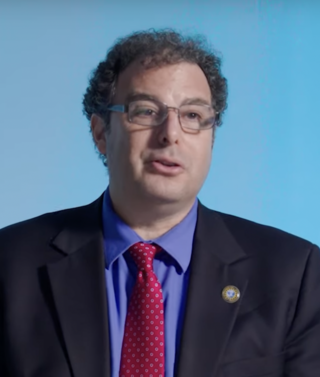
A crossword is a word game consisting of a grid of black and white squares, into which solvers enter words or phrases ("entries") crossing each other horizontally ("across") and vertically ("down") according to a set of clues. Each white square is typically filled with one letter, while the black squares are used to separate entries. The first white square in each entry is typically numbered to correspond to its clue.

Computer Go is the field of artificial intelligence (AI) dedicated to creating a computer program that plays the traditional board game Go. The field is sharply divided into two eras. Before 2015, the programs of the era were weak. The best efforts of the 1980s and 1990s produced only AIs that could be defeated by beginners, and AIs of the early 2000s were intermediate level at best. Professionals could defeat these programs even given handicaps of 10+ stones in favor of the AI. Many of the algorithms such as alpha-beta minimax that performed well as AIs for checkers and chess fell apart on Go's 19x19 board, as there were too many branching possibilities to consider. Creation of a human professional quality program with the techniques and hardware of the time was out of reach. Some AI researchers speculated that the problem was unsolvable without creation of human-like AI.
A CAPTCHA is a type of challenge–response test used in computing to determine whether the user is human in order to deter bot attacks and spam.

Peter Norvig is an American computer scientist and Distinguished Education Fellow at the Stanford Institute for Human-Centered AI. He previously served as a director of research and search quality at Google. Norvig is the co-author with Stuart J. Russell of the most popular textbook in the field of AI: Artificial Intelligence: A Modern Approach used in more than 1,500 universities in 135 countries.

Artificial Intelligence: A Modern Approach (AIMA) is a university textbook on artificial intelligence, written by Stuart J. Russell and Peter Norvig. It was first published in 1995, and the fourth edition of the book was released on 28 April 2020.

William F. Shortz is an American puzzle creator and editor who is the crossword editor for The New York Times. He graduated from Indiana University with a degree in the invented field of enigmatology. After starting his career at Penny Press and Games magazine, he was hired by The New York Times in 1993. Shortz's American Crossword Puzzle Tournament is the country's oldest and largest crossword tournament.
In artificial intelligence and operations research, constraint satisfaction is the process of finding a solution through a set of constraints that impose conditions that the variables must satisfy. A solution is therefore an assignment of values to the variables that satisfies all constraints—that is, a point in the feasible region.

The Cross-Wits is an American syndicated game show which premiered on December 15, 1975, and lasted for five seasons until its cancellation on September 12, 1980. The show was hosted by Jack Clark, with Jerri Fiala as hostess. Announcing duties were handled by John Harlan, Jay Stewart, and Jerry Bishop. The show was produced by Ralph Edwards Productions and distributed by Metromedia Producers Corporation.

Robert Anthony Kowalski is an American-British logician and computer scientist, whose research is concerned with developing both human-oriented models of computing and computational models of human thinking. He has spent most of his career in the United Kingdom.

The American Crossword Puzzle Tournament (ACPT) is a crossword-solving tournament held annually in February, March, or April. Founded in 1978 by Will Shortz, who still directs the tournament, it is the oldest and largest crossword tournament held in the United States; the 2023 event set an attendance record with more than 750 competitors.
God's algorithm is a notion originating in discussions of ways to solve the Rubik's Cube puzzle, but which can also be applied to other combinatorial puzzles and mathematical games. It refers to any algorithm which produces a solution having the fewest possible moves. The allusion to the deity is based on the notion that an omniscient being would know an optimal step from any given configuration.
Computer bridge is the playing of the game contract bridge using computer software. After years of limited progress, since around the end of the 20th century the field of computer bridge has made major advances. In 1996 the American Contract Bridge League (ACBL) established an official World Computer-Bridge Championship, to be held annually along with a major bridge event. The first championship took place in 1997 at the North American Bridge Championships in Albuquerque. Since 1999 the event has been conducted as a joint activity of the American Contract Bridge League and the World Bridge Federation. Alvin Levy, ACBL Board member, initiated this championship and has coordinated the event annually since its inception. The event history, articles and publications, analysis, and playing records can be found at the official website.

The New York Times crossword is a daily American-style crossword puzzle published in The New York Times, syndicated to more than 300 other newspapers and journals, and released online on the newspaper's website and mobile apps as part of The New York Times Games.

Michael Lederman Littman is a computer scientist, researcher, educator, and author. His research interests focus on reinforcement learning. He is currently a University Professor of Computer Science at Brown University, where he has taught since 2012.

Progress in artificial intelligence (AI) refers to the advances, milestones, and breakthroughs that have been achieved in the field of artificial intelligence over time. AI is a multidisciplinary branch of computer science that aims to create machines and systems capable of performing tasks that typically require human intelligence. Artificial intelligence applications have been used in a wide range of fields including medical diagnosis, economic-financial applications, robot control, law, scientific discovery, video games, and toys. However, many AI applications are not perceived as AI: "A lot of cutting edge AI has filtered into general applications, often without being called AI because once something becomes useful enough and common enough it's not labeled AI anymore." "Many thousands of AI applications are deeply embedded in the infrastructure of every industry." In the late 1990s and early 21st century, AI technology became widely used as elements of larger systems, but the field was rarely credited for these successes at the time.

Bruce Wilcox is an artificial intelligence programmer.
The WebCrow is a research project carried out at the Information Engineering Department of the University of Siena with the purpose of automatically solving crosswords.

Lichess is a free and open-source Internet chess server run by a non-profit organization of the same name. Users of the site can play online chess anonymously and optionally register an account to play rated games. Lichess is ad-free and all the features are available for free, as the site is funded by donations from patrons. Features include chess puzzles, computer analysis, tournaments and chess variants.

Marie desJardins is an American computer scientist, known for her research on artificial intelligence and computer science education. She is also active in broadening participation in computing.

Dan Feyer is an American crossword puzzle solver and editor. He holds the record for the most American Crossword Puzzle Tournament (ACPT) championships, with nine wins, and the most consecutive championships, with six. He was described by The New York Times as "the wizard who is fastest of all", solving the Times's Saturday crossword in an average of 4:03 minutes each week and the Sunday crossword in an average of 5:38 minutes.














